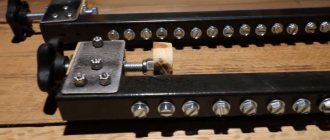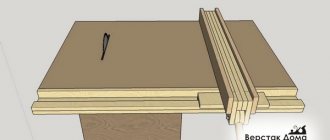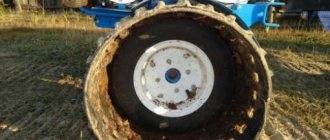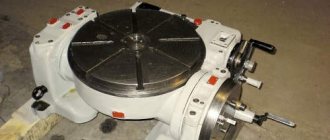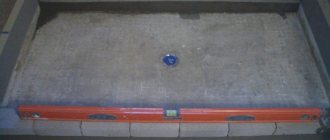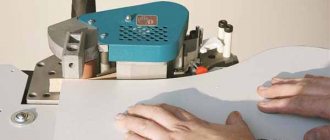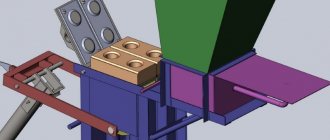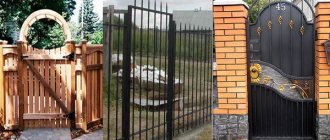How is a circular saw used?
A circular saw is used at home to cut wood perfectly evenly. To ensure a high-quality long cut, the following conditions are necessary: a huge speed of rotation of the disk, high quality of the cutting edge, reliability of the entire structure, ergonomics and absolute safety.
A do-it-yourself wood sawing machine will become an indispensable assistant in the construction of a country house, a wooden utility room or garage, barn and bathhouse.
And during home repairs, a do-it-yourself mini-circular is simply an invaluable piece of equipment that helps you quickly prepare planks, beams and slats, and cut sheets into fragments of any required size.
A DIY circular table is a new degree of freedom in working with wood. Having such equipment, you can quickly erect a fence, gates and gates, a gazebo, garden arches, home furniture - cabinets, chairs, tables, shelves, racks.
If a circular saw from a hand-held circular saw is equipped with a special disk, it will be possible to cut even sheets of aluminum and other materials up to two millimeters thick.
Possible options for small, DIY circular saws
Any stationary circular machine, even a homemade one, requires a fairly spacious workshop. The space should allow not only to install the unit itself, but also to place the workpieces intended for cutting in the desired position. If the task is not to cut large-sized wood, but simply, if necessary, you need to make your own slats or bars for repairing furniture, etc., it would be more rational to acquire a mini table saw.
You can make such a device yourself, using the same principles as when creating stationary machines from an angle grinder or a circular saw. Only the stand will not be a trestle, the support of which is the floor, but a frame on which a small table with a fixed hand tool is installed.
On a note! When making a circular saw of this type, it is important to take into account the overall height of the structure, that is, the plane on which the material intended for sawing will be located. Overestimating or underestimating the level will cause significant inconvenience.
A miniature machine is more functional and safer to use.
If you need to create a mini circular saw with your own hands to make very small workpieces (aircraft, ship modeling), you can assemble the tool using a PVC pipe as a body and borrowing an engine from children's toys. It is easy to make a hole for the shaft in such a pipe. You can use a glue gun as a connecting material. Such a circular machine can be powered either from the mains or from a battery. To ensure autonomous operation, it is necessary to provide a special compartment for batteries in the housing.
Design features
The possibility of safe long-term work on a homemade circular saw depends on the operating modes, reliability and ergonomics of the designed machine.
Knowledge of woodworking technology and the specifics of specialized equipment will allow you to create a table for a circular saw with your own hands, characterized by simplicity and durability.
Basic materials and tools
To create a circular saw you will need the following materials:
The nodes you will need are:
The work cannot be done without tools and materials:
Disk speed and security
Without ensuring high speed of the toothed disk, it is impossible to guarantee the quality of the cut. However, for homemade equipment operated in a home workshop, safety during operation is no less important.
It is necessary to provide protective devices that are traditionally equipped with industrial designs. The opinion that one can completely do without such protection at home does not stand up to criticism.
TB rules are “written in blood.” All it takes is one awkward movement to end up on the surgeon's table. Therefore, security should be given the utmost attention.
Scope of application of a homemade saw
The main task of this equipment is to make a perfect long cut in wood. In order to guarantee the quality of a cut with a circular saw, several conditions are necessary: high speed of the cutting edge, its sharpness, the rigidity of the disk-working surface system, safety, strength and convenience.
The small dimensions of the circular saw do not make it possible to use it during the construction of a house, when wood is required in large quantities, because the functionality of homemade equipment is not so wide.
But during repair work, such a machine will become a savior, an indispensable assistant. A circular saw will allow you to quickly and efficiently obtain all kinds of wooden blanks (blocks, planks, slats), and cut sheet material into slabs of the required sizes.
Having such a tool at hand, it is easy to make fences, shelves, racks, tables and chairs. If you install a special disk on it, then the homemade circular saw can even work with metal: both relatively soft aluminum and other materials, but their thickness should be a maximum of 2 mm.
Table stability
A DIY table for a circular table must be durable, reliable in use, and extremely stable. All functional units must withstand severe mechanical loads, since powerful vibration often occurs during operation.
If multidirectional impulses do not pose a danger to the master, then this can have a very negative effect on the quality of the cut: rough marks from the teeth are formed on the cut, and it becomes difficult to maintain the required dimensions of the finished parts.
Stationary machine
If a master dreams of taking up woodworking seriously, then he has only one way - making a full-fledged circular installation. Creating such a unit will take more effort and time, but during its operation it will recoup all costs. The only requirement is a well-thought-out drawing, so it is better to use ready-made diagrams that can be slightly “adjusted” to your conditions.
bed
This is the basis for any machine - the frame on which all the main structural elements are attached. It must be stable and reliable, so there is only one optimal material - unsurpassed metal. The best options are a thick-walled corner or the same profile pipe. Welding is usually used to fasten parts of a stationary machine. If a dismountable structure is planned, then it is possible to use a bolted connection, but in this case it will be difficult to call the fastening “strong”: it will require constant checking.
Tabletop
And here metal is also a favorite. The best materials would be steel or aluminum alloys. A possible option is thick plywood, which is covered with sheet iron. An ideal tabletop for any woodworking machine must have a smooth surface, be able to resist friction, and easily support weights of up to 50-60 kg, without the slightest hint of deflection.
A hole is made in it for the disk. There are two options that are used in the case of a circular saw:
The second method is preferable for a metal tabletop, since cutting a groove at home is a rather complicated operation. A parallel stop is attached to the tabletop. A convenient metal corner is often used in this role. A hole is also made to attach it. An alternative is reliable and powerful clamps.
Motor
The choice of engine for a future circular saw depends on what kind of lumber they plan to process. If disks with a diameter of 150-170 mm are used, then a unit with a power of 0.5 kW will be sufficient for them. For larger disks (from 350 mm), a more serious engine is suitable - at least 1.1 kW.
If the circular saw is located outdoors (for example, on the street under a canopy), then you can even use a gasoline engine with low power. It is possible to make it removable.
Rotation transmission
The best drive for a circular saw is a V-belt drive. In this case, 2 pulleys are used: the first on the engine, the second on the drive shaft. The reasons for this choice are safety and convenience: in the event of a minor emergency, the belt will simply slip, notifying the technician about the need to turn off the device.
Pulleys that have different annular grooves (grooves) or diameters make it easier to regulate the disk speed, which allows you to find the optimal mode for processing different types of wood. The shaft to which rotation is transmitted from the rotor is almost impossible to make with your own hands, so this part has to be purchased or ordered from a turner. The bearings used to install the shaft must be sealed, otherwise their service life will be short.
Design options
When exploring the question of how to make a circular saw with your own hands, you can work out several options:
Note!
- Do-it-yourself compressor: selection of materials and tools for assembly at home + step-by-step instructions for making and assembling yourself
Homemade products for the garage with your own hands: options for products for arranging a garage, detailed diagrams and drawings for creating with your own hands
Do-it-yourself press - design features, choice of manufacturing materials. Step-by-step instructions for making it yourself + simple diagrams and drawings
- A circular grinder, which is mounted on a machine made of wooden beams and boards.
- Installation on the frame of a hand-held circular saw.
- Making a stationary circular saw from an old wooden table and a washing machine motor.
- Manufacturing a frame from a metal profile, followed by installation of a powerful electric motor taken from any industrial equipment.
All these options have shown their viability in practice. The advantages and disadvantages of these schemes can only be determined by comparison, but for each of the creators of the designs, his brainchild is certainly the best.
If you plan to saw thick boards using a circular saw, a weak engine is unlikely to cope with this. A thick array requires a powerful electric motor and a metal machine.
Using a grinder as a working unit, it will be possible to trim small bars, but for long-term work, during which long deep cuts are made, it is not suitable, since the continuous operation time of a tool of this type is very limited.
The engine from the washing machine will require the creation of a gearbox. Experience shows that you cannot expect high performance and excellent cutting quality from a circular saw equipped with a washing machine motor.
Design of a stationary circular saw
A stationary circular saw is designed to perform fairly large volumes of work. The design of the implemented option in two forms is presented in the diagram below. It also shows the main dimensions of the installation, which are recommended to be used as a starting point for self-assembly.
In the drawing, the numbers correspond to the following structural elements of homemade equipment:
It is better to place the starting device in a visible place on the panel (made of dielectric material) so that access to it is free. It is also recommended to equip the machine with an emergency switch. It is convenient when it is large in size.
Focusing on your own needs, you can improve the unit by making it with a jointer or planer. To do this, it is enough to secure a drum with knives on the existing shaft, and make a slot of the appropriate size in the table for it. This will allow you to expand the functionality of the created installation: plan lumber on it, chamfer and select a quarter from wooden blanks.
If you plan to regularly perform carpentry operations using homemade equipment, it is recommended to equip it with a coordinate table with several guides. They need to be fixed at different angles. To organize productive work, it should also be possible to regulate the speed of the electric motor and quickly replace disks if necessary.
Circular saw from a hand-held circular saw
There is a common belief among home craftsmen that the easiest way to acquire a bench saw is to mount a hand-held circular saw on the bed. This improvement allows you to:
Note!
- Do-it-yourself winch: classification, manufacturing materials, description of work stages + instructions for DIY construction
Do-it-yourself clamp - step-by-step production and description of options for using a clamp
DIY knife | A step-by-step description of how and from what materials to make a homemade knife
- Maximum cutting quality thanks to the high rotation speed of the sawing edge disc.
- Good resistance to radial loads thanks to reliable bearings of a professionally designed and manufactured device.
- Easy replacement of the working element, which does not require complex manipulations.
The main advantage of the design using an angle grinder is a compact, powerful electric motor that provides maximum performance at enormous speeds and torque.
Purpose
circular saw with jointer
The machine combines the capabilities of a circular saw and a jointer. The circular saw is used for sawing large volumes of timber, boards, laminate, plywood, drywall, and soft alloy products. Sawing is carried out quickly, accurately and precisely to size, which cannot be achieved using hand tools.
The jointer is designed to remove the top, rough layer of material and make the workpiece smooth. Only wood is processed on jointing machines. There are double-sided models that simultaneously process two planes. The operations performed on circular and jointing machines are carried out one after another, so it is logical to combine them into a single device.
Advantages of a circular saw from a hand-held power tool
Let us list the main advantages of the scheme under consideration:
- Own forced ventilation.
- Excellent productivity with small volumes of processed material.
- Simple fixation of the disk, easy maintenance of the device.
- Possibility of obtaining cuts of different depths by selecting the appropriate disc.
Bed and table
Creating an easel circular saw using hand-held power tools begins with constructing a tabletop or box-shaped body, where a hand-held circular saw will be located below, and part of the sawing disk will be placed above the surface.
You can find many reviews on the Internet that present a do-it-yourself circular table with drawings, as well as a detailed description of the manufacturing technology.
Usually, if you have to work with small parts, a length of 1.5 m and a width of 0.7 m is sufficient for comfortable work. The frame can be welded from a metal corner with a shelf of up to 30 mm. At the corners, the frame should be reinforced with welded jibs, which will ensure maximum reliability.
Note!
DIY vices: simple and reliable homemade vices from A to Z (190 photos)Do-it-yourself vibrating table - selection of materials, components and assemblies for a vibrating table with a step-by-step manufacturing description
Do-it-yourself grain crusher - operating principle, types and features of creating a device for processing grain crops
It is best to make the table from chipboard or MDF. Often thick plywood is also used. If you have sheets of thin plywood available, you can join two sheets together. It is necessary to secure the tabletop symmetrically to the base to avoid the risk of tipping over.
A rectangular window is made in the middle of the tabletop, which is then closed with an insert made of duralumin or plexiglass with a slot for the disk. This insert allows for smooth movement of the board or sheet being processed along the ruler.
Recommendations for simplifying the assembly process
To regulate belt tension, the electric motor must be installed so that it can be moved. The easiest way to achieve this is by creating larger slots than required for the motor mounting bolts. In this case, the expansion of the holes should be carried out in the direction of belt tension.
If you completely follow the drawing, you will need to make a more complex belt tensioning mechanism. The process will be carried out by pulling up the platform with the electric motor using studs and fixing it with locking bolts in the desired position (in the drawing these structural elements are indicated by the number 10).
The entire design and assembly process can be greatly simplified if you make a circular saw from a circular saw. In this case, there is no need to install a number of parts (motor, disk, shaft, belt, starter). But the capabilities of the created model will be limited by the power of the tool used.
In any case, a homemade circular machine must be grounded. It is also additionally recommended to install a residual current device or differential circuit breaker in the panel. These measures will protect against electric shock if the machine body is energized, for example, due to breakdown of wire insulation. It is better to select components for the electrical part of a circular saw so that they are suitable for repair and easy to maintain. Free access to equipment components will help you easily replace failed parts.
Guide
To reliably guide a long board over the saw blade, the table top must be equipped with a sufficiently long guide. The parallel stop for a circular saw with your own hands should be adjustable. It is necessary that the ruler can move parallel to the cutting plane.
You can make a parallel stop from a corner with a wide shelf or a pine board. The design of the clamps can be arbitrary, as long as the stop does not move during hard work.
Miter saw
Trimming from a manual circular saw is a device for transverse cutting of planks, beams and boards to specified sizes. In principle, you can cut a board or beam crosswise while holding a hand saw in your hands. But when high precision cutting is required, it is better for the tool to be fixed.
If you have to work with a large volume of material, it is logical to build a homemade cross-cutting machine by constructing a simple frame and fixing a manual circular saw on it so that you can bring it to the material being processed and then move it back to its original position.
Structurally, control is carried out according to different schemes: you can build runners along which the hand saw will move back and forth with the force of the worker. There are options when the saw is mounted on a lever, which brings the tool to the wood from top to bottom.
What discs should you use for circular saws?
The productivity and quality of work largely depends on the correctly selected disk for a hand-made circular saw made from an angle grinder, a hand saw, or one assembled from separate mechanisms. It should be remembered that there are differences between discs for wood and metal. Even if thin, soft aluminum will be sawed, the appropriate blade must be installed. Metal cutting wheels have finer teeth. There are universal disc options that are suitable for working with both wood and metal.
There are also differences between the discs intended for longitudinal and transverse sawing of wood. Longitudinal sawing is carried out with a cutting attachment with sparse large teeth. But cross-cutting will be of better quality if discs with fine, frequent teeth are used.
As for the material and method of manufacturing disks, they can be monolithic or carbide. Monolithic ones are made from a single piece of high-carbon steel. Such bits are inexpensive, but have a significant drawback: they quickly become dull and require sharpening and re-wiring.
Circular discs can be made for wood or metal.
Carbide discs are made of tool steel with cobalt and tungsten brazing. They are more wear-resistant, but the price of such products is much higher.
The outer diameter of the disks for a homemade circular saw is limited by the dimensions of the protective casing. The standard disc thickness is 3.2 mm. There are thinner and thicker saw wheels. Thin ones are used when working with wood of valuable tree species to make a clean cut. For rougher work, thick discs are recommended.
